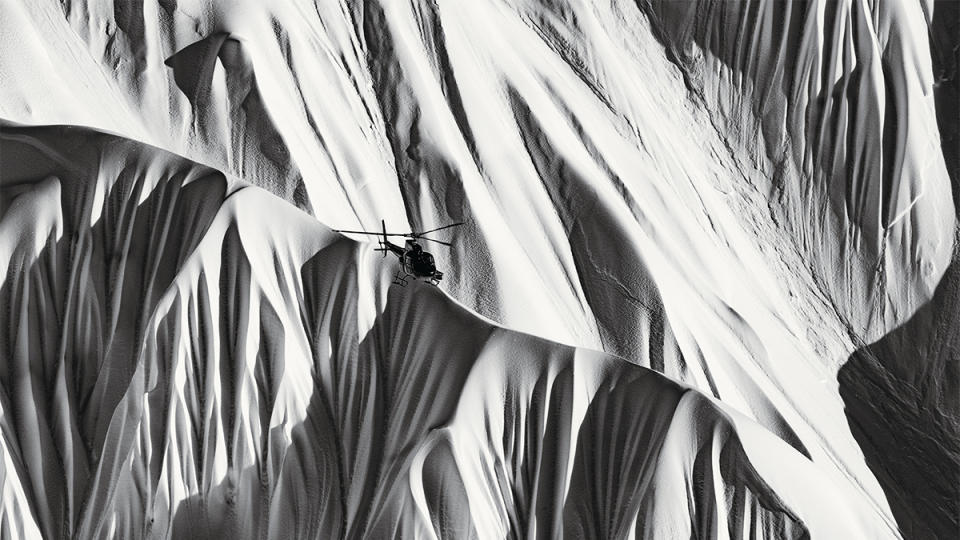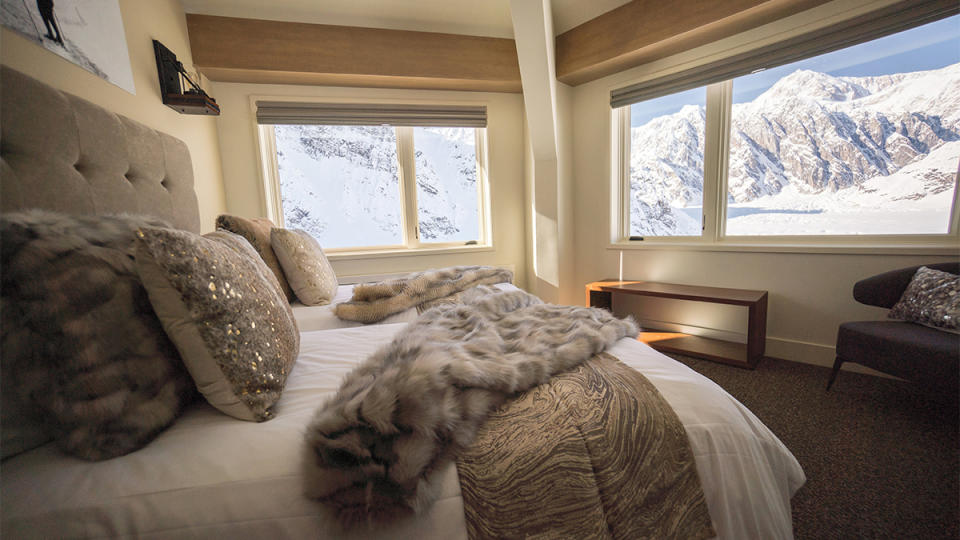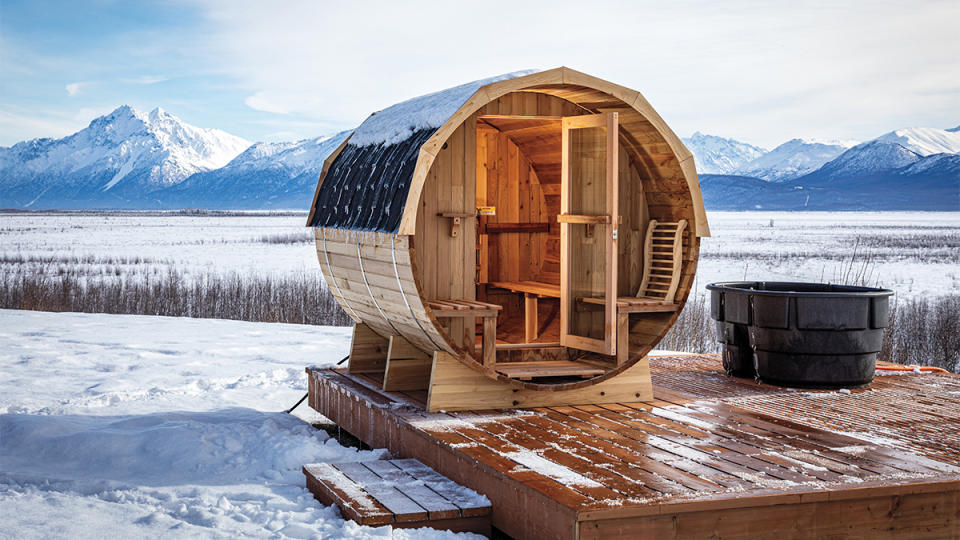How Two Ski Chalets Are Redefining Luxury Travel in Alaska

It’s not uncommon to hear that once you’ve skied in Alaska, anywhere else is bound to be a letdown. And it’s true that, after hitting slopes all over the world, my first taste of Alaska’s gravity-defying mountains about a decade ago delivered the most epic day of snowboarding I’d ever experienced. But that high came to an abrupt end with a mediocre steak dinner at a Best Western sports bar. Being dropped by helicopter on a knife-edge ridge and carving fresh tracks on pristine 40-degree inclines may have been mind-blowing, but the next year I opted for the Alps.
The apex of big-mountain skiing, the 49th state should be on every enthusiast’s go-now list. Yet for many snow-obsessed travelers, an ideal day requires more than steep runs and deep powder. They want creature comforts off the slopes—and Alaska was hardly Aspen or Gstaad. The dining was uninspired and the lodgings often a communal situation that could feel like a frat party after a few hours of après ski.
More from Robb Report
These 5-Star, Cold-Weather Destinations Make for Surprisingly Steamy Honeymoons
These Two Ski Clubs Are Bringing Aspen-Style Luxury to Northeast Slopes
Today, Alaska remains one of the last frontiers for remote, untrammeled skiing, but is no longer a stranger to luxury. Two new exclusive-use properties are redefining the travel experience in the Land of the Midnight Sun. The five-bedroom Sheldon Chalet, set just below the peak of Denali, and Eagle’s Nest, a six-bedroom heli-ski lodge near Wasilla, rival any accommodations in the Alps when it comes to amenities, cuisine, and hospitality. But their unique access to Alaska’s formidable peaks and their world-class guides put them in a league of their own.

Eagle’s Nest is the highly anticipated base of Third Edge Heli. When the heli-ski company launched in 2015, it delivered such thrilling, adrenaline-pumping experiences that clients didn’t mind that it operated out of a handful of rustic, low-frills backcountry lodges. Founder Greg Harms even referred to his followers as crackheads because of their unquenchable desire to chase virgin snow and rip big lines, and many would have been willing to overnight in igloos for the opportunity to pursue untouched powder with him.
Stories about Harms are common within the adventure-travel community. People describe him as magnetic and say his six-foot-five-inch, 225-pound frame was perfectly suited to the ruggedness of Alaska. He started guiding there in 2003 and quickly became one of the most sought-after heli-ski experts on the planet, with a reputation for notching numerous first descents. When he founded Third Edge, he immediately had a waiting list of clients hoping to follow him year-round down mountains in Canada, Chile, and Iceland. Alaska, however, remained the holy grail for true powder addicts: When it comes to extreme skiing, there’s no better terrain. Coastal winter-weather patterns plaster the state’s enormous peaks with a magical maritime snow that dehydrates into a velvety surface with unfathomable stability, even on super-steep slopes.
Harms was killed in a helicopter accident in 2021 at the age of 52. But you get a sense of his personality the minute you step foot in Eagle’s Nest. Tributes such as black-and-white photos of him dropping into couloirs and shredding perilous spines, plus pillows crocheted with “Fuck yeah”—his favorite saying—are scattered throughout the house.

Brad Cosgrove and Jeff Hoke, two longtime Third Edge guides, honored their mentor’s memory by taking over the business. When they started reaching out to clients about trips, only one otherwise loyal crackhead hesitated. “Don’t you think it’s time to grow up from the ski-bum lifestyle and finally get a lodge?” he asked, adding that he’d be more than willing to fund a comfortable base. After nearly a year of searching, the partners found their dream headquarters and welcomed their first guests in 2022.
Eagle’s Nest rewrites all the rules of heli-skiing in Alaska. First, it’s remarkably accessible—particularly for a state with such vast wilderness—at just a 10-minute helicopter flight or an hour’s drive from Anchorage airport. Although located in a residential enclave right outside downtown Wasilla, the lodge fronts a 20,000-acre protected wildlife refuge, making it feel miles from civilization. Backyard sightings of moose, eagles, coyotes, and sandhill cranes happen regularly.
What they offer isn’t for the masses—they serve a subset of a subset of a subset.– Frank A. Baer III
Second, it’s designed to be your own private ski party. A family from North Carolina was gracious enough to let me crash their final day. When I arrived in the late afternoon, they were sprawled across couches and beanbag chairs in front of a big screen in the high-ceilinged living room, watching the drone footage of them skiing shot by their pilots. A fire crackled in the slate-stone hearth; the bar had been freshly stocked with glacier ice for cocktails.
The property also eschews the Alaskan-lodge stereotype—log-hewn and rustically spartan—feeling more like a contemporary mountainside mansion, with a neutral palette of blues and grays and modern light fixtures. Six single-occupancy bedrooms (couples can, of course, share, but the two helicopters have space for three guests each) feature private bathrooms with local bath salts, and many have gas-burning fireplaces. There’s a massage room, equipped with foam rollers and stability balls; outside, a hot tub, a cold plunge pool, and a sauna are set on a sprawling deck with views of the Chugach Mountains.

Had Harms been able to see Eagle’s Nest’s ultimate location, he no doubt would have bellowed his favorite phrase. Most heli operations in Alaska have access to a single mountain range, putting them at the mercy of the weather and making no-fly days inevitable: On one two-week trip through the state, I tallied just three and a half (admittedly amazing) days of snowboarding. The rest were spent hanging out in a lodge.
Cosgrove and Hoke are the snow savants who have finally bested the unpredictable weather patterns here by strategically positioning their base in the middle of five separate mountain ranges, almost guaranteeing the Third Edge team can place clients in optimal conditions each day. In its first season, the operation had an unheard-of 90 percent fly rate. And while many companies make larger groups share a single helicopter, Third Edge’s private model allows clients total freedom and customization. A party of six is split between two A-Star helicopters, each with a pair of guides, and receives a generous 14 hours of fly time for the week. (Most operations average 10 hours and rarely hit that quota.) It’s not unusual, particularly given Alaska’s long hours of spring sunlight, for Third Edge guests to experience three mountain ranges in a single day.
“They’ve cracked the code of Alaska heli-skiing,” says Frank A. Baer III, a self-proclaimed crackhead who booked two stays at Eagle’s Nest within three weeks in April 2023 and quickly secured a week for 2024. “What they offer isn’t for the masses—they serve a subset of a subset of a subset,” he notes. “They’re catering to a very special brotherhood that Greg created.”
Baer, a 62-year-old insurance executive from West Virginia, recalls his first heli-ski trips in the late 1980s: There were four guides, each assigned to one group of 11 skiers, with all 44 guests packed into shared rooms in a single lodge. “I don’t know how anyone can still have that model today,” he says. A decade-plus run of adventures with Harms began in 2010, and Baer was instantly hooked on his unique ability to coach people to new levels of performance. “Harms had a sixth sense that allowed him to read a client and put them just on the edge of their ability,” he recalls. “I became completely addicted to that feeling.”
That “sixth sense” has been ingrained in all of the Third Edge specialists. “A lot of people collect art or fine wines or classic cars,” says Baer. “I collect ski guides, and anyone vetted by Greg is someone I want in my collection. I’m not a pro athlete; I’m an insurance salesman—I can’t access the backcountry safely without guys like Brad and Jeff.”
A typical day at Eagle’s Nest might start with breakfast quesadillas and reindeer-sausage scones served in the airy, open kitchen. Guests gear up, walk 20 steps along a heated path to the helipads, and depart to ski to their personal content. Some, like the family from North Carolina, might be satisfied with a half day’s worth of turns before requesting a flight to lunch at Sheldon Chalet or a heli transfer to the fabulous new Nordic Spa at Alyeska Resort, where they can rotate through an alfresco circuit of hot and cold plunges, barrel saunas, and steam rooms.

Others, like Baer, will ski to the max, bagging 17 runs across three mountain ranges, eating picnic lunches in the wild or perhaps making a pit stop for burgers at a roadhouse in the tiny frontier town of Talkeetna. Then they’ll ski some more before returning to the lodge to freshen up for an 8 p.m. dinner of king-crab legs and filet mignon.
Limited winter daylight hours (in January, Wasilla sees barely six hours of sun) mean Alaska’s ski season doesn’t begin until February, and stable snow conditions typically last through April. With just six rooms and a 12-week ski window, Eagle’s Nest has its devotees frothing for reservations. Guests have a 14-day rebooking period after a stay to secure the same week the following year, and 90 percent of clients from 2023 reserved a spot for 2024. The lodge has a wait list a season out, which explains the urgency to rebook: Give up your spot and you may never get it back.
A generation before Harms, a trailblazing American bush pilot named Don Sheldon was pioneering glacier landings and performing daring rescues on Denali, the highest peak in North America. In the late 1960s, he hosted skiers at a humble hut built on a five-acre glacial island, called a nunatak, 10 miles from Denali’s summit; the minuscule 212-square-foot mountain house had a month-plus wait for overnight reservations. (Sheldon died of cancer in 1975, at the age of 54.) Today, the bare-bones base still attracts hard-core skiers who don’t mind using an outhouse and preparing meals on a camp stove. But more discerning adventurers now have the option to stay at Sheldon Chalet, a two-story, 2,000-square-foot guesthouse located just 500 feet away.
They’ve cracked the code of Alaska heli-skiing.
– Frank A. Baer III
Built by Sheldon’s children and grandchildren, the inn mimics the hexagonal shape of the original mountain house—six sides bolster its ability to withstand the hurricane-force winds that can occur in this harsh environment—but inside it channels a glitzy Alps chalet more than the antler-filled lodges typical of Alaska. Each of the five bedrooms has a king-size bed covered in a faux-fur throw and pillows, with a single large-format vintage photo commemorating Sheldon’s glory days hanging on the wall. Fittingly, glacial views from the panoramic windows steal the show. Books chronicling Sheldon’s aerial heroics and his years mapping the Alaska Range with cartographer Bradford Washburn line the shelves of the living room; the open kitchen is stocked with snacks including pickled spruce tips and Alaskan-salmon jerky.
When the chalet opened in 2018, the 30-minute helicopter transfer from Talkeetna satisfied most guests’ thrill quota. Upon arrival, visitors were content to simply soak in the beauty of their raw, remote surroundings, ogling Denali through the sauna’s picture window or marveling at the aurora borealis transforming the winter sky into a psychedelic light show. With no cell signal or Wi-Fi, Sheldon Chalet provides a rare opportunity to truly unplug, but its location amid a 35-square-mile glacier cirque and towering peaks also makes it a dream playground for ski touring.

In 2021, the team began offering guided backcountry skiing on the glacier. Last spring, after being spoiled with heli drops from Third Edge, I traveled to Sheldon Chalet to spend three days ascending peaks under my own power, then schussing down. On the ride from Talkeetna, our group oohed and aahed as we soared above frozen taiga and sparkling turquoise glacier pools, then fell silent as the chopper was swallowed by the 5,000-foot-tall granite walls of the Great Gorge. Weather was moving in fast, and after circling the sheer rock five times, our pilot shot through a sliver of cloud opening for the big reveal: Perched at 6,000 feet at the head of the nearly 35-mile-long Ruth Glacier, Sheldon Chalet stood glowing like an alpine beacon.
Concierge Elise MacMillan greeted us on the helipad with glasses of Taittinger Champagne and ushered us into the lodge, where chef Dave Thorne had prepared a seafood feast of Alaskan king-crab legs, Simpson Bay oysters, and spot shrimp from Prince William Sound. In my room, a large duffel filled with every imaginable type of outdoor apparel—ski bibs, puffy jackets, thermals—supplied by the chalet’s partner outfitter, Glacier View Gear Rental, ensured I’d stay warm and dry no matter the conditions, which is no small feat in Alaska.
The next morning the mountains were being shy, hiding behind the weather, allowing us a leisurely breakfast of egg-white frittatas and local morel mushrooms (the chalet works with a forager in Talkeetna). While we waited for the clouds to move out, my guide, Turrell Moore, reviewed my avalanche equipment and gave me a safety tutorial. Glaciers are riddled with cracks in the ice sheet known as crevasses. “Small cracks,” she warned, “may be gaping chasms,” and can be hundreds of feet deep. Moore scouts the terrain daily and keeps detailed notes on the location of crevasses across the glacier, but we would still travel uphill roped together, in the hope that if one person crashed through, the other could break the fall. She also had me wear a harness hooked with carabiners, so if I did end up at the bottom of a crevasse, she’d be able to throw me a rope and belay me back to the surface. My heli pursuits from days earlier suddenly felt tame.

Outside, I attached skins—fabric strips that allow a skier to move uphill—to the bottom of my splitboard, and once I was securely roped to Moore, we shuffled up the glacier, carefully zig-zagging around crevasses. For every 30-minute skin up the 7,000-foot-high glacier, I was rewarded with a cruise-y, five-minute descent in fresh powder and a chorus of my own hoots and hollers reverberating off the icy peaks.
Over the next two days, we’d spend two to three hours in search of fresh lines. I tested my mettle on Cameron’s Couloir: Since it was too steep to skin, I boot packed over half a mile up so I could snowboard back down the powder-filled gully. You could easily while away a week skinning up untouched ridgelines and pocket skiing around the Ruth Gorge. Each afternoon, I returned to the chalet physically exhausted and utterly famished for Thorne’s preparations of organic corn chowder and smoked Kodiak scallops with blood orange and Thai basil.
Some evenings, Moore and fellow guide Sean Johnson would take us sledding just below the house, where a hill unfurls onto a runway that the guides sometimes have to stomp out by foot so planes can land. That feeling of floating amid the peaks triggered memories of hut-to-hut European ski trips from one remote alpine refugio to another. But with Sheldon Chalet, Eagle’s Nest, and new luxe properties incoming from Eleven Experience and other brands, I suddenly found myself asking a question I hadn’t contemplated since that mediocre steak in the grungy Best Western: Who needs the Alps?
Ski season runs from mid-March through June at Sheldon Chalet, where rates range from $96,000 for up to four guests for three nights to $192,500 for 10 guests. The season at Third Edge Heli spans February through April. One week of heli-skiing at Eagle’s Nest Lodge is $42,000 per person for up to six people.
Best of Robb Report
The Ultimate Miami Spa Guide: 15 Luxurious Places to Treat Yourself
The 7 Most Insanely Luxurious Spas in the World, From Tokyo to Iceland
17 Reasons the Caribbean Should Be at the Top of Your Travel Itinerary
Sign up for Robb Report's Newsletter. For the latest news, follow us on Facebook, Twitter, and Instagram.


